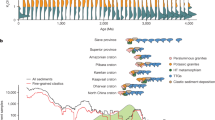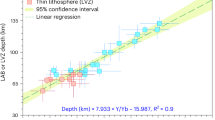Abstract
DETAILED work which I have done in the Loch Lomond area suggests a definite answer to the above problem which is of some importance since it concerns one of the major geological features of the British Isles. The direction in which the principal stress acted in the production of the fault can be approximately determined from the pattern of structures in the Lower Old Red Sandstone conglomerates, and this supports the contention put forward in stratigraphical accounts (summarized by J. G. C. Anderson1) that the Highland Boundary Fault is a reverse fault of Caledonian age and not a Proto-Armorican wrench fault as envisaged by E. M. Anderson2.
This is a preview of subscription content, access via your institution
Access options
Subscribe to this journal
Receive 51 print issues and online access
$199.00 per year
only $3.90 per issue
Buy this article
- Purchase on Springer Link
- Instant access to full article PDF
Prices may be subject to local taxes which are calculated during checkout
Similar content being viewed by others
References
Anderson, J. G. C., Trans. Roy. Soc. Edin., 61, Pt. 2, 479 (1947).
Anderson, E. M., The Dynamics of Faulting (Edinburgh, 1951).
Du Toit, A. L., Trans. Geol. Soc. Edin., 8, Pt. 3, 315 (1905).
Griggs, D., and Handin, J., Geol. Soc. Amer. Mem., 79, 347 (1960).
Author information
Authors and Affiliations
Rights and permissions
About this article
Cite this article
RAMSAY, D. The Highland Boundary Fault : Reverse or Wrench Fault?. Nature 195, 1190–1191 (1962). https://doi.org/10.1038/1951190b0
Issue Date:
DOI: https://doi.org/10.1038/1951190b0
This article is cited by
-
Regional-scale fluid flow and element mobility in Barrow’s metamorphic zones, Stonehaven, Scotland
Contributions to Mineralogy and Petrology (2005)
Comments
By submitting a comment you agree to abide by our Terms and Community Guidelines. If you find something abusive or that does not comply with our terms or guidelines please flag it as inappropriate.



